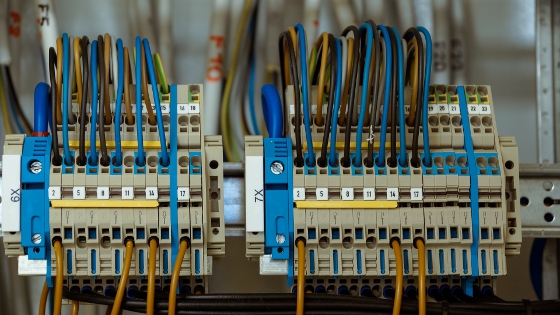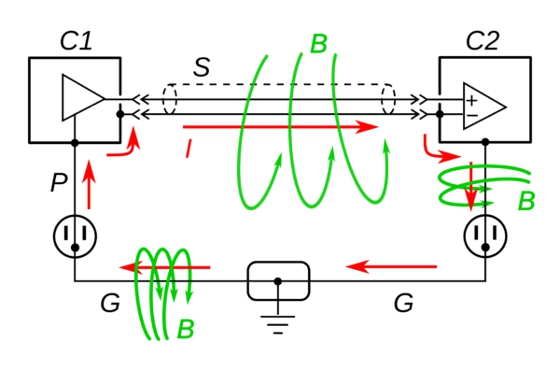 |
| May 28, 2024 | Volume 20 Issue 20 |
Designfax weekly eMagazine
Archives
Partners
Manufacturing Center
Product Spotlight
Modern Applications News
Metalworking Ideas For
Today's Job Shops
Tooling and Production
Strategies for large
metalworking plants
Engineer's Toolbox: What is ground loop feedback and how can it be eliminated?

By CAS DataLoggers engineering
Most workers already know that proper grounding is a fundamental safety precaution for all kinds of electrical equipment. However, it's less well known that while grounding can prevent and resolve many safety and power issues, improper grounding can create problems in data logging, data acquisition, and measurement and control systems.
One of the most common problems is known as ground loop feedback -- an electrical phenomenon often resulting when different electrical circuits within a system and its peripherals have different connections or paths back to earth ground. Furthermore, this can also be a seasonal issue where problems come and go based on climatic conditions. The application specialists at CAS DataLoggers have put together this brief introduction on the subject.
Ground loop feedback explained
Ground loop feedback is a frequently encountered wiring issue arising when two or more connected electrical devices have more than one path to earth ground. Together, the separate paths form a loop. Electrical and magnetic fields which flow through the loop can generate unintended currents and voltages, or the ground points of the different devices may not be at the same potential voltage due to current and resistance in the ground path. The net effect is that while it is believed that the devices have the same ground reference point, in fact, they don't, and this difference can appear as a simple offset in measured values or as signal noise that corrupts the devices' normal operation.
Whether using different safety grounds or a safety ground and an earth ground, one of the most common examples is buzzing/humming sounds caused by currents induced in ground loops from mains (60 Hz) AC power. In video applications, users will notice this feedback in the form of onscreen stripes, while computer and networking users can experience shutdowns or gaps in their data communication. Engineers and technicians collecting data often find that their readings and data show offsets that may change over time or noise in the measured values. In a worst-case scenario, this could cause an interruption in operations, since many businesses heavily rely on PLCs and measurement systems for process and machine control, quality control, final test, etc. Yet ground loops often escape troubleshooting investigations and are equally neglected as a factor in many installations, arising later when electrical configuration or environmental conditions change -- for example, as the resistance to ground changes because of changes in soil moisture content.
Computers, data loggers, and data acquisition/control systems are normally connected to the ground through their AC power supply and the ground pin on the plug that goes into the wall outlet that shares the ground wire in common building wiring. These devices may also be connected to each other by data communications cables. Ethernet cables are pretty good at maintaining ground isolation, but serial communications cables, RS232 for example, have their own ground conductor. Now if the computer is plugged into an outlet in one area of the building and an RS232 device it is connected to is in a different area of the building, it can create a multi-path connection and a ground loop.
Another example is a computer controlling a piece of manufacturing equipment. The computer is probably plugged into a standard 110 VAC out, but the manufacturing machine may require 220 or 480 VAC, so it is fed from a different breaker panel than the PC. Each breaker panel can have its own local ground stakes. Ideally, these ground stakes are supposed to be no resistance on that ground wire and no voltage drop.
However, we have seen cases where, for whatever reason, there is resistance in the path to local ground. It could be a bad connection on one of the ground wires or it could be that at certain times of the year, the area around the ground stake becomes very dry and there is some non-zero resistance to true earth ground. The result is that the computer and the machine it is controlling don't share the same true ground, which can result in erratic operation or even complete shutdown.
Ground loops can also affect low-level measurements through the effect of cabling. Normally, for sensitive measurements, a shielded cable will be used; the purpose of the shield is to protect the signal from any electromagnetic interference in the environment. It will be collected by the shield and carried to the ground, keeping the sensitive signal clean. However, if by mistake the shield is connected to the ground at both ends, it will immediately create a potential ground loop. Now any electrical interference or varying magnetic field in the environment will create a current in the shield, which will then be coupled directly to the signal being measured in the form of electrical noise.

Changing magnetic field causes current in the shield and low side of signal conductor, inducing a voltage offset error in measurements.
Increasingly, ground loop feedback poses a threat to industrial processes given the sensitivity of newer electrical equipment. As an example, the more recent variable frequency AC drives can be controlled by an external analog voltage signal. These drives may have a sensitive input front end, and when encountering noise on the control signal the drives can experience errors or even failure.
The balancing act of grounding
Grounding serves a critical safety function by preventing electrical shock. However, in electronic systems, proper grounding also plays a role in minimizing electrical noise that can degrade signal quality. This creates a crucial, yet delicate, balancing act: achieving optimal system performance requires a well-designed grounding scheme that prioritizes both safety and noise reduction.
The culprits: Different ground potentials, multiple paths to ground
In a perfect world, all grounding points would be at the exact same electrical potential. Unfortunately, reality paints a different picture. Factors like temperature, soil moisture, and even the number and type of devices connected to the ground can introduce slight variations in resistance between grounding points. When current flows through the ground path of a system, these resistance differences can create minute voltage variations, and ground loop problems are created. The most common scenario for ground loops occurs when multiple interconnected devices are plugged into separate circuits in the same area that have different grounding paths.
If the connection between these devices includes a ground conductor or even a shield, it creates a closed loop where electrical current can circulate and induce unwanted noise into the system. Additionally, nearby AC power lines, motors, transformers, or other sources of electromagnetic interference (EMI) can exacerbate these issues.
Mitigating ground loop feedback
Combating ground loop feedback requires a multi-pronged approach:
- Prevention is paramount: A well-designed system with attention to proper grounding and wiring practices is the first line of defense. Ideally, all grounds for sensitive equipment should be brought back to a single point in a star topology, and from this point, a low resistance cable runs back to a good earth ground. Prior to installation, a thorough inspection for any faults in the electrical system is crucial.
- Separate ground by function: Ground circuits related to measurements should be kept separate from safety grounds or ground that are connected to high-power equipment. Ideally, each of these should have their own ground "tree" and only be coupled together at a low-impedance physical ground point.
- Avoid multiple connections to ground: One of the most common ground loop issues is caused by connecting the shield of a cable to the ground at each end. This will immediately create a ground loop such that any EMI in the area will induce a current in the shield.
- Reduce interference: Try to reduce or remove nearby EMI interference from AC power lines or high-power equipment. If this is unavoidable, use a shielded cable with one end of the shield connected to the ground.
- Isolation is your ally: In situations where multiple grounding points are unavoidable, employing signal isolation techniques can prevent current flow through unintended paths. Shielded cables can further enhance noise reduction for low-current applications as long as step 3 above is followed.
Galvanic isolation for data acquisition
When working with data acquisition systems, consider utilizing data loggers equipped with galvanic isolation. This design feature provides isolation between the sensitive measurement circuitry and the power supply circuits and communications interfaces. It makes them less susceptible to creating ground loops between the sensors, measurement circuitry, and computers used to process the data, ensuring accurate measurements.
Conclusion
By understanding the root causes of ground loop feedback and implementing the mitigation strategies outlined above, system integrators and operators can significantly reduce the likelihood of encountering this common, yet often perplexing, issue. A well-grounded system, coupled with meticulous planning and proper equipment selection, paves the way for accurate measurements, uninterrupted data transfers, and a trouble-free data acquisition experience.
See what CAS DataLoggers has to offer at dataloggerinc.com.
Published May 2024
Rate this article
View our terms of use and privacy policy
